
Multi-Sided Platforms
Def_Pattern No. 3
MULTI-SIDED PLATFORMS bring together two or more distinct but interdependent groups of customers. • Such platforms are of value to one group of customers only if the other groups of customers are also present. • The platform creates value by facilitating interactions between the different groups. • A multi-sided platform grows in value to the extent that it attracts more users, a phenomenon known as the network effect.
[ REF·ER·ENCES ]
1 • “Strategies for Two-Sided Markets.” Harvard Business Review. Eisenmann, Parker, Van Alstyne. October 2006.
2 • Invisible Engines: How Software Platforms Drive Innovation and Transform Industries. Evans, Hagiu, Schmalensee. 2006.
3 • “Managing the Maze of Multisided Markets.” Strategy & Business. Evans, David. Fall 2003.
[ EX·AM·PLES ]
Visa, Google, eBay, Microsoft Windows, Financial Times

Customer Segment A
Multi-sided platforms, known by economists as multi-sided markets, are an important business phenomenon. They have existed for a long time, but proliferated with the rise of information technology. The Visa credit card, the Microsoft Windows operating system, the Financial Times, Google, the Wii game console, and Facebook are just a few examples of successful multi-sided platforms. We address them here because they represent an increasingly important business model pattern.
What exactly are multi-sided platforms? They are platforms that bring together two or more distinct but interdependent groups of customers. They create value as intermediaries by connecting these groups. Credit cards, for example, link merchants with cardholders; computer operating systems link hardware manufacturers, application developers, and users; newspapers link readers and advertisers; video gaming consoles link game developers with players. The key is that the platform must attract and serve all groups simultaneously in order to create value. The platform’s value for a particular user group depends substantially on the number of users on the platform’s “other sides.” A video game console will only attract buyers if enough games are available for the platform. On the other hand, game developers will develop games for a new video console only if a substantial number of gamers already use it. Hence multi-sided platforms often face a “chicken and egg” dilemma.
One way multi-sided platforms solve this problem is by subsidizing a Customer Segment. Though a platform operator incurs costs by serving all customer groups, it often decides to lure one segment to the platform with an inexpensive or free Value Proposition in order to subsequently attract users of the platform’s “other side.” One difficulty multi-sided platform operators face is understanding which side to subsidize and how to price correctly to attract customers.
Segment B
One example is Metro, the free daily newspaper that originated in Stockholm and can now be found in many large cities worldwide. It launched in 1995 and immediately attracted a large readership because it was distributed free of charge to urban commuters in train and bus stations throughout Stockholm. This allowed it to attract advertisers and rapidly become profitable. Another example is Microsoft, which gave its Windows software development kit (SDK) away for free to encourage development of new applications for its operating system. The larger number of applications attracted more users to the Windows platform and increased Microsoft’s revenues. Sony’s Playstation 3 game console, on the other hand, is an example of a multi-sided platform strategy that backfired. Sony subsidized each console purchased in hopes of later collecting more game royalties. This strategy performed poorly because fewer Playstation 3 games sold than Sony initially estimated.
Operators of multi-sided platforms must ask themselves several key questions: Can we attract sufficient numbers of customers for each side of the platform? Which side is more price sensitive? Can that side be enticed by a subsidized offer? Will the other side of the platform generate sufficient revenues to cover the subsidies?
The following pages outline three examples of multi-sided platform patterns. First, we sketch Google’s multi-sided platform business model. Then we show how Nintendo, Sony, and Microsoft compete with slightly different multi-sided platform patterns. Finally, we describe how Apple has slowly evolved into an operator of a powerful multi-sided platform.
Google’s Business Model
The heart of Google’s business model is its Value Proposition of providing extremely targeted text advertising globally over the Web. Through a service called AdWords, advertisers can publish advertisements and sponsored links on Google’s search pages (and on an affiliated content network as we will later see). The ads are displayed alongside search results when people use the Google search engine. Google ensures that only ads relevant to the search term are displayed. The service is attractive to advertisers because it allows them to tailor online campaigns to specific searches and particular demographic targets. The model only works, though, if many people use Google’s search engine. The more people Google reaches, the more ads it can display and the greater the value created for advertisers.
Google’s Value Proposition to advertisers depends heavily on the number of customers it attracts to its Web site. So Google caters to this second group of consumer customers with a powerful search engine and a growing number of tools such as Gmail (Web based e-mail), Google maps, and Picasa (an online photo album) among others. To extend its reach even further, Google designed a third service that enables its ads to be displayed on other, non-Google Web sites. This service, called AdSense, allows third parties to earn a portion of Google’s advertising revenue by showing Google ads on their own sites. AdSense automatically analyzes a participating Web site’s content and displays relevant text and image ads to visitors. The Value Proposition to these third party Web site owners, Google’s third Customer Segment, is to enable them to earn money from their content.

Google offers distinct Value Propositions to three interdependent Customer Segments
As a multi-sided platform Google has a very distinct revenue model. It makes money from one Customer Segment, advertisers, while subsidizing free offers to two other segments: Web surfers and content owners. This is logical because the more ads it displays to Web surfers, the more it earns from advertisers. Increased advertising earnings, in turn, motivates even more content owners to become AdSense partners. Advertisers don’t directly buy advertising space from Google. They bid on ad-related keywords associated with either search terms or content on third party Web sites. The bidding occurs through an AdWords auction service: the more popular a keyword, the more an advertiser has to pay for it. The substantial revenue that Google earns from AdWords allows it to continuously improve its free offers to search engine and AdSense users.
Google’s Key Resource is its search platform, which powers three different services: Web search (Google.com), advertising (AdWords), and third-party content monetization (AdSense). These services are based on highly complex proprietary search and matchmaking algorithms supported by an extensive IT infrastructure. Google’s three Key Activities can be defined as follows: (1) building and maintaining the search infrastructure, (2) managing the three main services, and (3) promoting the platform to new users, content owners, and advertisers.

Google has one main Revenue Stream that subsidizes other offers (Revenue Stream is replaced by “free”)
Wii versus PSP/Xbox Same Pattern, Different Focus
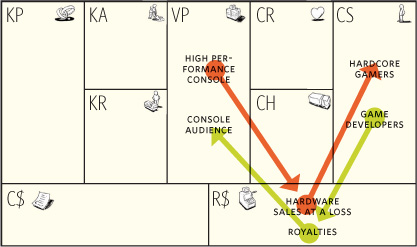
PSP/Xbox Focus
Video game consoles, today a multi-billion dollar business, provide good examples of double-sided platforms. On one hand, a console manufacturer has to draw as many players as possible to attract game developers. On the other hand, players only buy the hardware if there is a sufficient number of interesting games available for that console. In the game industry, this has led to a fierce battle between three main competitors and their respective devices: the Sony Playstation series, the Microsoft Xbox series, and the Nintendo Wii. All three are based on double-sided platforms, but there are substantial differences between the Sony/Microsoft business model and Nintendo’s approach, demonstrating that there is no “proven” solution for a given market.
Sony and Microsoft dominated the game console market until Nintendo’s Wii swept the sector with a fresh approach to technology and an astonishingly different business model. Before launching the Wii, Nintendo was spiraling downward, rapidly losing market share, and teetering on the edge of bankruptcy. The Wii console changed all that and catapulted the company to the market leader position.
Traditionally, video console manufacturers targeted avid gamers and competed on console price and performance. For this audience of “hardcore gamers” graphics and game quality and processor speed were the main selection criteria. As a consequence, manufacturers developed extremely sophisticated and expensive consoles and sold them at a loss for years, subsidizing the hardware with two other revenue sources.
First, they developed and sold their own games for their own consoles. Second, they earned royalties from third party developers who paid for the right to create games for specific consoles. This is the typical pattern of a double-sided platform business model: one side, the consumer, is heavily subsidized to deliver as many consoles as possible to the market. Money is then earned from the other side of the platform: game developers.
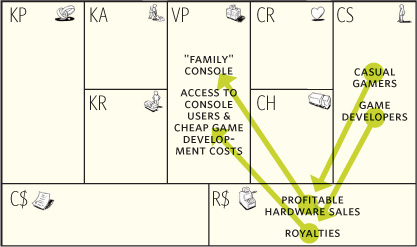
Same pattern, but different business model: Nintendo’s Wii
Wii Focus
Nintendo’s Wii changed all this. Like its competitors, the Wii is based on a double-sided platform business, but with substantially different elements. Nintendo aimed its consoles at the huge audience of casual gamers rather than the smaller “traditional” market of avid gamers. It won the hearts of casual gamers with relatively inexpensive machines equipped with a special remote control device that allows players to control the action with physical gestures. The novelty and fun of motion-controlled games such as Wii Sports, Wii Music, and Wii Fit attracted enormous numbers of casual gamers. This differentiator is also the basis for the new type of double-sided platform that Nintendo created.
Sony and Microsoft competed with costly, proprietary, state-of-the-art technology aimed at avid gamers and subsidized it in order to gain market share and keep hardware prices affordable. Nintendo, on the other hand, focused on a market segment that was far less sensitive to technological performance. Instead, it lured customers with its motion-controlled “fun factor.” This was a much cheaper technological innovation compared to new, more powerful chipsets. Thus, the Nintendo Wii was less costly to produce, allowing the company to forego commercialization subsidies. This is the main difference between Nintendo and rivals Sony and Microsoft: Nintendo earns money from both sides of its double-sided Wii platform. It generates profits on each console sold to consumers and pockets royalties from game developers.
To summarize, three interlinked business model factors explain the commercial success of the Wii: (1) low-cost differentiation of the product (motion control), (2) focus on a new, untapped market that cares less about technology (casual gamers), and (3) a double-sided platform pattern that generates revenues from both “sides” of the Wii. All three represent clean breaks from past game sector traditions.
Apple’s Evolution into a Platform Operator
The evolution of Apple’s product line from the iPod to the iPhone highlights the company’s transition to a powerful platform business model pattern. The iPod was initially a stand-alone device. The iPhone, on the contrary, evolved into a powerful multi-sided platform for which Apple controls third party applications through its App Store.
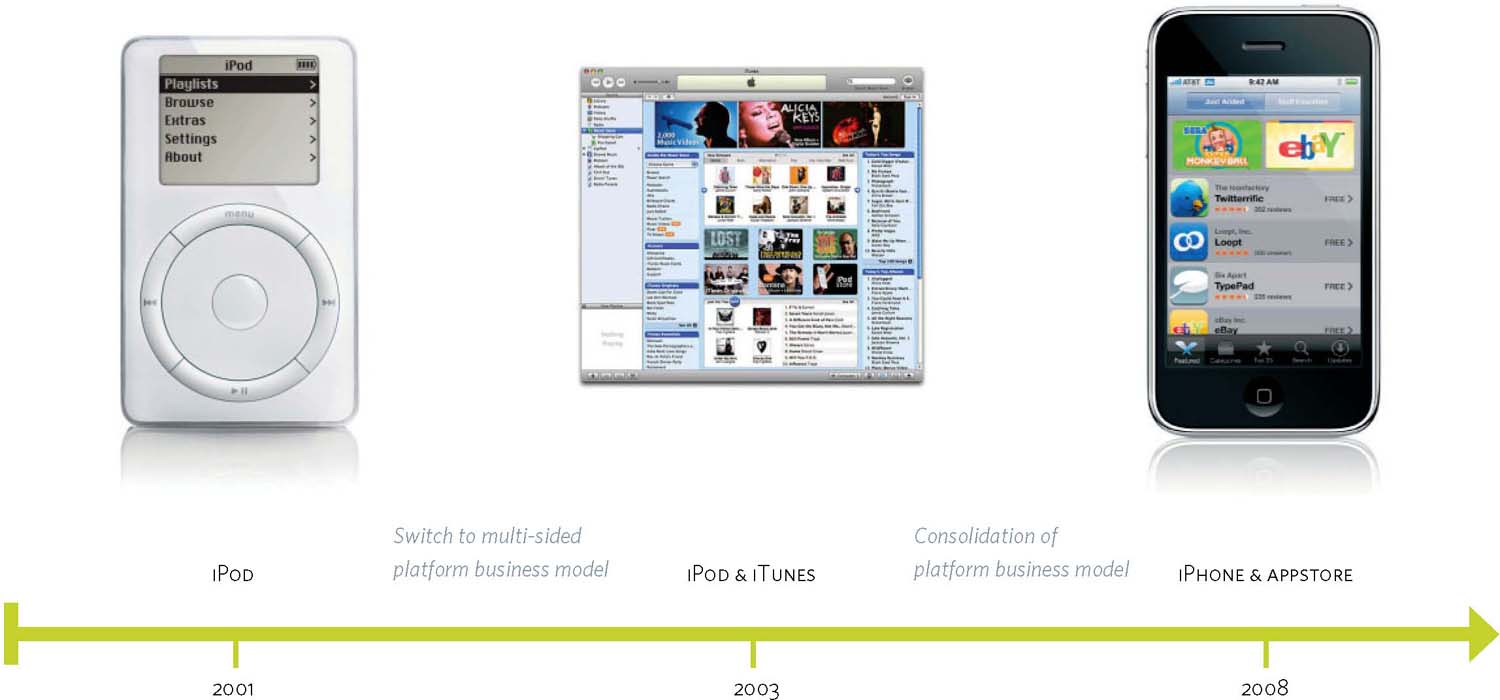
iPOD 2001

Apple introduced the iPod in 2001 as a standalone product. Users could copy their CDs and download music from the Internet onto the device. The iPod represented a technology platform for storing music from various sources. At this point, though, Apple was not exploiting the platform aspect of the iPod in its business model.
(Switch to multi-sided platform business model)
iPOD & iTUNES
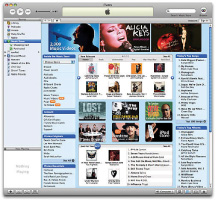
In 2003 Apple introduced the iTunes Music Store, which was closely integrated with the iPod. The store allowed users to buy and download digital music in an extremely convenient way. The store was Apple’s first attempt at exploiting platform effects. iTunes essentially connected “music rightsholders” directly with buyers. This strategy catapulted Apple to its position today as the world’s largest online music retailer.
(Consolidation of platform business model)
iPHONE & APPSTORE 2008
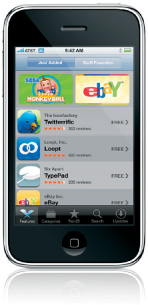
In 2008 Apple consolidated its platform strategy by launching its App Store for the highly popular iPhone. The App Store allows users to browse, buy, and download applications directly from the iTunes Store and install them on their iPhones. Application developers must channel sales of all applications through the App Store, with Apple collecting a 30 percent royalty on each application sold.